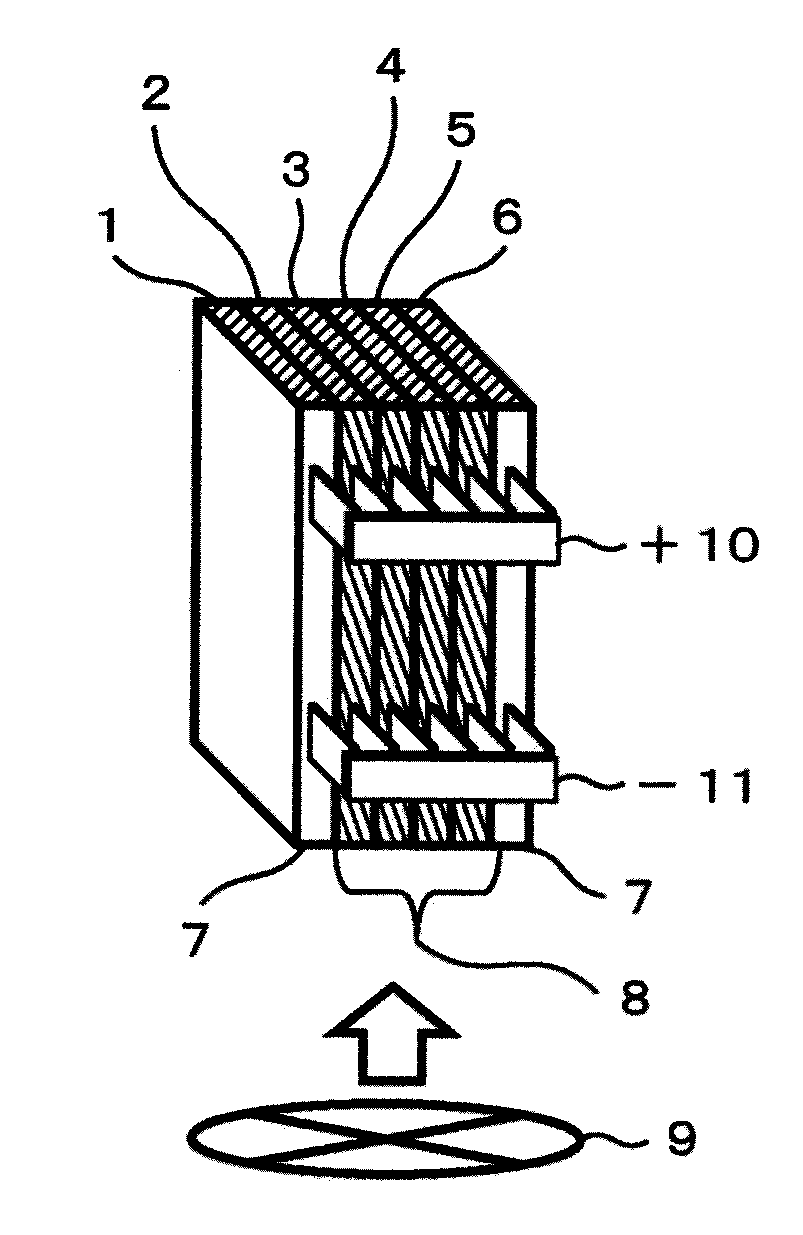Lithium-ion rechargeable battery module, vehicle with the battery module and generating system with the battery module
a rechargeable battery and battery module technology, applied in secondary cell details, sustainable manufacturing/processing, batteries, etc., can solve the problems of insufficient improvement of high-temperature storage characteristics of battery cells, insufficient high-temperature storage characteristics, and inability to prevent temperature rise at high temperature portions, etc., to achieve good high-temperature storage characteristics, reduce capacity, and resist the effect of increasing
- Summary
- Abstract
- Description
- Claims
- Application Information
AI Technical Summary
Benefits of technology
Problems solved by technology
Method used
Image
Examples
embodiment 1
[0045](Battery Module Construction of Embodiment 1)
[0046]The construction of an embodiment 1 is shown in FIG. 1. Lithium-ion battery cells 1-6 were laminate sheet type cells each 6.5 mm thick. Six of these lithium-ion cells were stacked together and electrically connected in parallel to form a battery module. Of the six stacked cells, four at the center exposed to high temperatures (cells 2-5 in FIG. 1) were high resistance heat-tolerant battery cells 8 with higher VC and EC concentrations in the electrolyte than the two normal battery cells 7 installed at the ends of the module (cells 1, 6 in FIG. 1). The high resistance heat-tolerant battery cells 8 were found to be about 1.2 times higher in resistance at 20° C. and have a higher capacity retention rate when stored at 50° C. than the normal cells 7. The maximum allowable temperatures, with the battery cell longevity taken into account, were set at 50° C. for the high resistance heat-tolerant cells 8 and 45° C. for the normal cells...
embodiment 2
[0059](Battery Module Construction of Embodiment 2)
[0060]The construction of a second embodiment is shown in FIG. 7. A cylindrical cell 67 mm in diameter was used for the lithium-ion cell. The cylindrical cells were arrayed in five layers stacked one upon the other vertically, with the vertically arranged cells electrically connected in parallel and the horizontally arranged cells connected in series. These cells were spaced 10 mm from one another vertically and horizontally. They were cooled by the cooling fan 9 blowing air against them at 1.5 m / s.
[0061]Of the vertically arranged cells, those in upper two tiers (fourth and fifth tier in FIG. 7) that are heated to high temperatures employed high resistance heat-tolerant cells 8 having higher VC and EC concentrations in the electrolyte than those of normal cells 7 located at a central portion (second and third tier in FIG. 7). The high resistance heat-tolerant cells 8 was found to be about 1.5 times higher in resistance at 20° C. and...
embodiment 3
[0068]The lithium-ion rechargeable battery module shown in the embodiment 1 and the embodiment 2 can be used as a power supply for a variety of vehicles, such as hybrid trains that travel on both engine and motor, electric cars using batteries as an energy source for motor; hybrid cars, plug-in hybrid cars whose batteries can be charged by external sources, and fuel cell cars that derive electric energy from the chemical reaction between hydrogen and oxygen.
[0069]A schematic plan view of a typical drive system for an electric car (vehicle) 30 is shown in FIG. 13.
[0070]An electric energy is supplied from a battery module 16 through a battery controller and a motor controller, both not shown, to a motor 17 to drive the electric car 30. During deceleration, an electric energy regenerated by the motor 17 is stored in the battery module 16 through the battery controller.
[0071]The application of the battery module 16 of this invention to an electric car (vehicle) 30 as in the embodiment 3...
PUM
 Login to View More
Login to View More Abstract
Description
Claims
Application Information
 Login to View More
Login to View More - R&D
- Intellectual Property
- Life Sciences
- Materials
- Tech Scout
- Unparalleled Data Quality
- Higher Quality Content
- 60% Fewer Hallucinations
Browse by: Latest US Patents, China's latest patents, Technical Efficacy Thesaurus, Application Domain, Technology Topic, Popular Technical Reports.
© 2025 PatSnap. All rights reserved.Legal|Privacy policy|Modern Slavery Act Transparency Statement|Sitemap|About US| Contact US: help@patsnap.com



